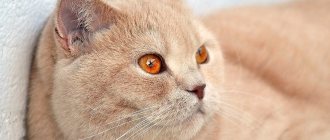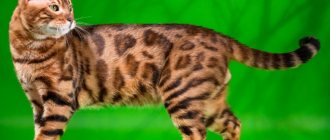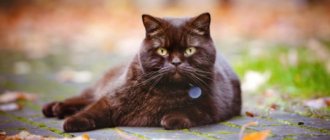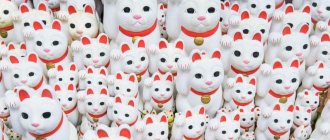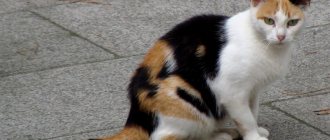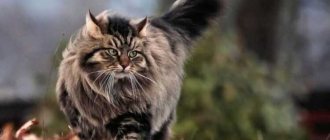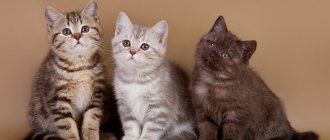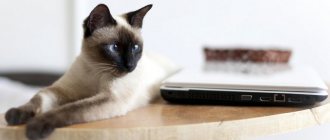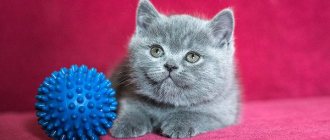Charming chubby dogs with amber button eyes and silky shiny fur, literally of a royal color.
This is how the British Blue breed is described. Below will be a description of the British blue cat with a photo and their character, as well as basic information that you should pay attention to when choosing a pet. The British cat breed, as you might guess from the name, appeared in England as a result of crossing a Persian cat with a domestic English breed. This happened at the beginning of the 19th century, the breed came out to the public at an exhibition in the Crystal Palace.
History of the origin of the British cat
Judging by the name itself, it becomes clear that the homeland of these cats is Great Britain. Historians suggest that these animals were brought to the British Isles by the ancient Romans around the first century AD.
The main advantage of those ancient representatives of the British was their short and very dense coat, which provided the animals with protection from moisture and harmful insects. It was thanks to this wool that the British quickly got used to and adapted to new living conditions.
They were excellent hunters, thanks to their high levels of endurance and well-developed physical fitness.
Due to their spectacular appearance, at the end of the 16th century, British felines began to be looked at not only as skilled hunters. And already in 1871, British individuals participated in the first cat exhibition in London.
Lilac
Lilac representatives are sometimes also represented as cream British. This is due to the color, which combines soft pink and blue. Words cannot describe the shade because it can vary and be different from one litter to another. Babies, immediately after birth, resemble pink piglets, their fur is so bright. As pets grow older, their fur coat becomes blue.
At the same time, animals owe their additional beauty to their undercoat, which is usually a tone and a half lighter than the main color. The eyes of representatives of this breed can only be amber or copper. If this is not the case, then it will not be possible to classify the animal as a lilac species. Many people want to have such pets, but the presented tone is very rare. Getting it is luck. Breeders have been struggling with this for years and in the end nothing works out.
Some people believe that the fawn is a cream-colored British cat, but this is incorrect. Newborns resemble small fawns with a light pink-cream shade of fur. Such representatives are extremely rare, which directly affects their very high cost. Experienced breeders recommend that when purchasing such cats, if you still manage to find them, you must ask for exactly this color and no other color to be included in the passport. The reason is that the presented shade can be determined solely by DNA analysis. If the seller refuses to enter the color into the passport, it means that they are trying to sell the wrong animal under the guise of an elite and expensive animal.
Description of the breed
The main characteristic feature of the British is power, especially when it comes to males.
Female cats are smaller in size than male cats. Squat height and rather large size, developed muscles and sternum - this is the image of a modern Briton. The head of these cats is large with rounded outlines. The muzzle has developed cheeks and cheekbones. Only the British have a pronounced fold of skin around the neck.
The nose is medium long, rather wide. When viewed in profile, you can see that the nose forms a depression in the frontal part. The ears are located quite widely, with a wide base. The shape is rounded, the size of the ears is medium.
British people have large, round eyes. Set wide apart. What distinguishes British cats is the color of their eyes, characteristic of the breed - it is bright orange.
Newborns may have blue eyes, however, over time they will change their color. It is very rare to come across cats with blue or green eyes.
Medium or short llamas are equipped with well-developed strong muscles. The tail is of medium length and looks proportional to the body.
How to get color
Initially, the black pigment eumelanin was chosen to obtain the blue color. Which is equally present in black and gray cats, but in the latter it is distributed sparsely and unevenly throughout the fur, this creates a dilution of coat color with the participation of the recessive gene D. This biological effect explains the presence of various shades in the British cat breed from blue, light to graphite. Breeders are well aware of the rule of genetics:
- male kitten - obtained from a blue parent;
- the kitten is a girl when both parents are blue.
Animal mating
Representatives of this breed belong to individuals with a late indicator of the development of reproductive systems.
Therefore, knitting a cat in its first year of life is strictly prohibited, because the animal may simply die. The body completes full development only by the age of 6 years.
Early mating of males before 2 years of age can lead to exhaustion, so in the future they will not be able to produce offspring.
British kittens are born completely similar to adults. Physiological features in the form of a disproportionate body are the norm for kittens. Over time, everything will return to normal, and the kitten will take on the appearance of a standard British cat.
Oriental cat - history of the breed, modern standards, character, care, nutrition + 83 photos- Maine Coon - history of occurrence, description of the breed, character + 84 photos
- Burma - a cat as a mascot, hygiene and health, character of the breed + 96 photos
Chocolate
You might think that most black cats turn chocolate over time, but this is not true. Babies, whom nature has endowed with such a shade, have a deep tone in childhood, but not very saturated. The beautiful chocolate shade makes itself felt in six months. The color is so monotonous that sometimes it is impossible to describe it in words. Breeders say that the cost is affected by the depth of color. In some countries, chocolate Britons are also called chestnut or havanna.
Character of the breed
The description of the character of the British cat says that these animals are suitable for people who spend little time within the walls of the house. These felines can cope just fine without human attention.
The British have a calm, aristocratic disposition. Even from the photo of a British cat it is clear that they know their worth and have a sense of unsurpassed dignity.
Along with this, they are very friendly and not aggressive. If they are often offended, they become withdrawn and unsociable.
If there is a child in the house, then such a cat will not be suitable for him as a fluffy toy. Otherwise, she will simply hide. British individuals get along well with other animals.
White
White beauties are incredibly gentle and soft. The skin has a light pink color. Often these are British people with blue eyes, but in some you can see aquamarine and even multi-colored. The animals' fur is so snow-white that it resembles ice shimmering in the sun or freshly fallen snow. The color can easily be classified as cold. Some people confuse this shade with yellowish, believing that this is the norm, but this is not the case. In the case when white turns into some other color or resembles more flesh-colored, it is no longer classified as this color.
Photo of a British cat
Shaded gold and silver color
Many chocolate, black and purple animals have a silver tint. This covers the pet's paws, belly, collar and chest.
As for the golden color or copper color, as breeders also say, it is rare. In this case, the coat is darker at the base, and at the end the hairs appear golden. It is impossible to confuse such pets with others, if only because they have a black tip of their tail, paw pads, and also eyeliner around their eyes. People call this type of cat the domestic chinchilla or the ticked British cat. This color of a British cat is not very rare, because breeders know well how to get it.
Marbled or wild
Marble color is a silver or white coat with dark stripes on top. Often the drawings are large in size. Very often, representatives of this color are called “snow leopards.” Some animals have stripes so uneven and large that it looks like the cat is two-colored. In recent years, not only light-colored cats have become marbled. The main tone can be chocolate, black, blue. On the “golden chinchilla” you can even find similar spots.
Animals belonging to a breed with this color have several subspecies, according to which they differ:
- We are talking about van - the main color is white.
- Bicolor - an animal with large white spots on its fur.
- Miteda - representatives with white paws, as well as a light-colored stripe from the chin to the groin.
- Tricolor is a tortoiseshell color with three shades, which necessarily includes white.
- Harlequin - a large white spot on the fur.
Source
Tabby
The British tabby is some kind of color mix, since the animals can have a golden or silver background, and can resemble a color point shade. On the body of adult animals there are often bright stripes or spots, like a leopard. Babies are brindle or spotted. This is not a deviation from the norm.
Spotted Britons are usually confused with other breeds, but they are distinguished by their eye color, as well as the shape of their ears and habits. In addition, the British have the most dense wool that representatives of the presented breed can boast of.
Content Features
Despite their natural health, Britons require proper care.
To extend your cat's life, choose the right food. Ideally, you should visit a veterinarian who will create a healthy diet. Take your pet to the veterinarian regularly: the cat will not complain if it gets sick.
Below are the best foods for British Shorthair cats:
Wet food for cats from 12 months View product
Dry food for cats from 12 months View product
Dry food for kittens from 4 to 12 months View product
It's easy to care for the cat's fur - buy a massage slicker brush and brush your cat 2 times a week. The Briton needs to be washed a couple of times a year or as needed.
Pay attention to the animal's eyes - they are looked after every day. A cotton pad is used to remove natural discharge from the eyes, and the cotton wool is led from the outer corner to the nose. The ears are examined a couple of times a month and cleaned with cotton wool treated with a hygienic solution.
You need to examine your pet's teeth every day to prevent tartar from developing. Breeders recommend teaching your British cat to brush his teeth from an early age.
Such pets are sensitive to drafts and catch colds easily: protect your cat from drafts.
